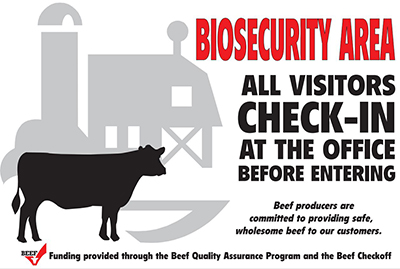Producers and consumers are responsible for food safety
6/10/24

ORANGE CITY, Iowa – Three USDA studies reaffirm the beef supply is safe! The first study examined 30 samples of ground beef collected from retail outlets in states with dairy herds testing positive for the H5N1 influenza virus. All 30 samples tested negative for H5N1. In another study, muscles from the carcasses of 96 condemned cull dairy cows were examined for H5N1. One carcass tested positive for the virus. But it’s important to note that when a carcass is condemned, it cannot enter the food chain. The second study compared the effect of three cooking temperatures (120°, 145°, and 160°F) of ground beef inoculated with a surrogate H5N1 virus. Cooking to 145° and 160°F destroyed the virus.
This is good news! But cattle producers and consumers still have a role in keeping the beef supply chain safe. Cattle producers need to be diligent in biosecurity. Consumers are responsible for proper handling and cooking.
Implement biosecurity
Simply defined, biosecurity is keeping diseases out of the cattle operation. However, implementing biosecurity is complex as it involves cattle, movements, people, equipment, and the environment.
It is critical that producers monitor the health of their cattle daily. An early sign of oncoming sickness is a change in appetite - taking longer to eat or not consuming all the provided feed. But look for other changes such as dryness of the nose, labored breathing, reduced activity, or abnormal feces, and isolate sick animals. Work closely with a local veterinarian to develop a treatment plan and conduct necropsies.
Producers should control movements on and off the farm. New incoming cattle need to be quarantined for a minimum of 28 days. Provide a single entry to the farm with a sign indicating where to check in. It’s appropriate to require all visitors to sign a registry log and to limit their contact with cattle.
Cleanliness and sanitation are key. Employees and visitors should wear clean clothing and footwear. Equipment such as front-end loaders, cattle trailers, and syringes should be clean before using and washed after using.
To avoid attracting wildlife, cover cattle feed when possible. Although it may not be possible to limit the access of wildlife to water, regular cleaning of tanks and waterers is recommended. Dispose of spoiled feed and dead animals in a manner that prevents attracting wild birds, rodents, and scavengers.
Safe handling and cooking
It is very important to cook beef to the appropriate temperature because undercooking can contribute to foodborne illness. The minimal internal temperature for steaks and roasts is 145°F. Ground beef should be cooked to a minimal internal temperature of 160°F.
Color of cooked beef is not an acceptable means to determine temperature. To get an accurate reading, insert a meat thermometer sideways into a patty. Be wary of food service establishments asking how you would like your hamburger cooked! Undercooked ground beef is not safe.
There is no substitute for cleanliness. To prevent cross-contamination, use two clean plates when grilling. Dedicate one for carrying raw beef to the grill and another to carry the grilled beef to the table.
Remember that everyone up and down the beef supply chain has a significant role in food safety!
-30-
The Iowa Beef Center at Iowa State University was established in 1996 with the goal of supporting the growth and vitality of the state’s beef cattle industry. It comprises faculty and staff from Iowa State University Extension and Outreach, College of Agriculture and Life Sciences and College of Veterinary Medicine, and works to develop and deliver the latest research-based information regarding the beef cattle industry. For more information about IBC, visit www.iowabeefcenter.org.
Contact:
Beth Doran, ISU extension beef specialist, 712-737-4230, doranb@iastate.edu
